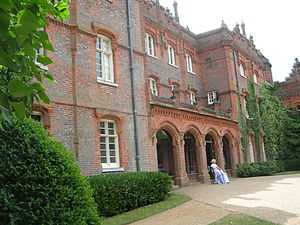Hughenden Manor

Hughenden Manor is a red brick Victorian mansion, located in High Wycombe, Buckinghamshire, England. In the 19th century, it was the country house of the Prime Minister, Benjamin Disraeli. Today, it is owned by the National Trust and fully open to the public.
The house sits on the brow of the hill to the west of the main A4128 road that links Hughenden to High Wycombe (Ordnance survey reference 165:SU866955).
History

The manor of Hughenden is first recorded in 1086, when formerly part of Queen Edith's lands it was held by William, son of Oger the Bishop of Bayeux, and was assessed for tax at 10 hides.
Benjamin Disraeli, British Prime Minister (1868 and 1874–1880, and Earl of Beaconsfield 1876), whose father rented a house at nearby Bradenham, purchased the manor in 1848[1] with the help of a loan of £25,000 (equivalent to almost £1,500,000 today) from Lord Henry Bentinck and Lord Titchfield, because as leader of the Conservative Party "it was essential to represent a county," and county members had to be landowners. He and his wife Mary Anne Disraeli, alternated between Hughenden and several homes in London.[2]
Disraeli's house
The present house was built towards the end of the 18th century and was of a stuccoed and of unassuming design.[3] However, in 1862 the Disraelis had the house remodelled by the architect Edward Buckton Lamb. Lamb has been described as "one of the most perverse and original of mid-Victorian architects" [4] Architecturally, he had a strong interest in the eclectic; this interest is very apparent in his work at Hughenden.
Under Lamb's hand, classical Georgian features were swept away as he "dramatised" the house.[5] Lamb worked in a hybrid baronial form of Gothic architecture, with exposed and angular juxtaposing brickwork surmounted by stepped battlements with diagonal pinnacles. The uppermost windows of the thirteen bayed garden facade were given unusual pediments - appearing almost as machicolations. The architectural historian Nickolaus Pevsner, in his highly critical appraisal of Lamb's work at Hughenden, labels these "window-heads" as "indescribable" and Lamb's overall Hughenden work as "excruciating." [6]
Pevsner clearly failed to appreciate what the delighted Disraeli described as the "romance he had been many years realising" while going to say that he imagined it was now "restored to what it was before the civil war".[7] As the house was not originally constructed until the middle of the 18th century, almost a century after the Civil War, that scenario would have been difficult.
The house is of three floors. The reception rooms are all on the ground floor. most with large plate glass windows (a Victorian innovation) giving onto the south-facing terrace overlooking a grassy parterre with views over the Hughenden Valley.
The west wing was built in 1910, long after Disraeli's death, when the house was in the ownership of his nephew Coningsby Disraeli.
Grounds
The park and woodlands total almost 1,500 acres (6.1 km2). The formal garden which was designed by Lady Beaconsfield (Queen Victoria created Mary Anne a Viscountess in her own right in 1868), has been restored to a similar condition to when occupied by the Disraelis. The long terrace at the rear of the house is decorated with Florentine vases. An obelisk on a nearby hill, visible from the house, was erected by Mary Anne in 1862 in memory of her father-in-law.
After Disraeli

Lady Beaconsfield died in 1872, and Disraeli in 1881; both were buried in a vault adjacent in the churchyard of St Michael and All Angels Church which is situated downhill from the main house, to the east.
The church contains a memorial to the Earl erected by Queen Victoria: the only instance a reigning monarch has ever erected a memorial to a subject. Disraeli had no children; he left Hughenden to his nephew, Coningsby. However, as Coningsby was only 14 at the time, his trustees rented out the property until he came into his inheritance in 1888. When Coningsby died in 1936, his widow left Hughenden, and the following year Disraeli's niece sold the house to W H Abbey, who vested it, with the remaining contents and 189 acres (0.76 km2), in the Disraelian Society.[8]
Modern history
During the Second World War, Hughenden Manor was used as a secret intelligence base code-named "Hillside". The UK Air Ministry staff at the manor analysed aerial photography of Germany and created maps for bombing missions, including the famous "Dambusters" raid.[9]
In 1947, the Abbey family and the Disraelian Society made Hughenden over to the National Trust.[10]
It is decorated as it might have been at the time it was occupied by Disraeli. It contains a collection of memorabilia including family portraits, Disraeli's own furnishings, a library including a collection of Disraeli's novels and one written and signed by Queen Victoria along with many of the books he inherited from his father Isaac D'Israeli.
Notes
- ↑ Darwin Porter, Danforth Prince Frommer's England 2006 pg. 243 Frommer's, Book&Map edition (2005) ISBN 0-7645-9540-7
- ↑ Robert Blake, Disraeli, 250–253.
- ↑ Pevsner, p173
- ↑ Garnett, p42
- ↑ Pevsner, p173
- ↑ Pevsner, p173
- ↑ Garnett, p42.
- ↑ Hughenden Manor, The National Trust
- ↑ "Secret base's WWII role revealed". BBC News. 25 April 2005.
- ↑ Hughenden Manor, The National Trust
References
- Pevsner, Nikolaus (1960 (1973 reprint)). The Buildings of England: Buckinghamshire. Middlesex: Penguin Books. ISBN 014070191 Check
|isbn=value (help).
- Garnett, Oliver (1997 (revised 2009)). Hughenden Manor. The National Trust. ISBN 978-1-84359-173-3.
External links
| Wikimedia Commons has media related to Hughenden Manor. |
- Hughenden Manor information at the National Trust
- Hughenden Parish, History of the county of Buckinghamshire
- Details from listed building database (46568) . Images of England. English Heritage.
Coordinates: 51°39′01″N 0°45′25″W / 51.65025°N 0.75698°W